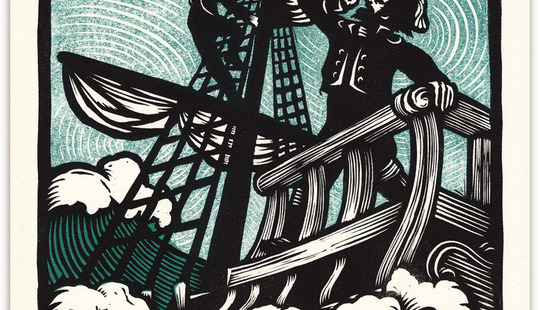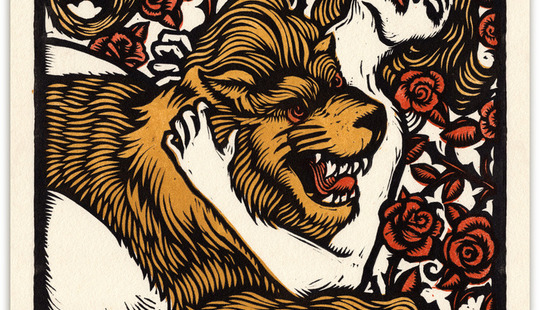Over the last few years, Vermont-based singer-songwriter Anaïs Mitchell has carved out a reputation as one of the most exciting performers on the modern folk circuit. 2010's folk-opera Hadestown - in which she set Greek legend against a sprawling, Depression-era backdrop - scored rhapsodic reviews, while last year's Young Man in America cemented her gift for underscoring grand themes with an uncommon eye for the intimate and the personal.
"We worship her music...it takes you to a very, very far-away place," says Bon Iver's Justin Vernon (who played Orpheus to her Eurydice on Hadestown), and he's right on the money. His band's cover of Young Man... highlight 'Coming Down' is a moving, wonderful thing that goes some way toward capturing the stark, immersive beauty of the original.
Her latest project takes a slightly different tack. A collaboration with fellow singer-songwriter Jefferson Hamer born out of their mutual appreciation of traditional folk music, the Child Ballads were originally compiled by American scholar and folklorist Francis James Child over ten massive volumes, complete with countless alternate versions and notations. Spanning hundreds of years of British and Celtic history, they offer valuable insight into the custom of oral storytelling, something that naturally piqued Mitchell's interest, as it has with numerous musicians over the years.
The duo resolved to interpret a handful of the ballads, but their task proved far from straightforward. In midwinter 2010 they made their first attempt at recording at Mitchell's house in Vermont. It didn't work out. The following year they started anew at a studio in Vancouver, but the sessions quickly spiralled out of control. "Once you start overdubbing and adding instruments, it's hard to know where to stop," rues Hamer.
Things finally came together under the guidance of esteemed producer Gary Pacsoza at his Nashville studio early last year, and the result is a set of dense, magical songs that sees Mitchell's sharp, expressive voice offset by Hamer's gentler tones. Like Mitchell's previous records, it is replete with carefully drawn, sympathetic characters who find themselves thrust into circumstances way beyond their control, balancing the mythic and the humane to moving, brilliant effect.
We sent a few questions over to Mitchell and Hamer and asked for some commentary on the ballads they chose. In a matter of days we received not only these thoughtful responses, but an extensive track-by-track walk-through of the album, which is presented unedited and accompanied by a selection of Peter Nevins' stunning print artwork below.
DiS: When exactly did you come across the Child Ballads? Were they something you immediately knew you wanted to work on?
Anaïs Mitchell: I was exposed to some of them as a kid, and then again as a young person by way of Bob Dylan, but it wasn't until a few years back that I started really delving deep into the catalogues of artists like Martin Carthy, Nic Jones, Fairport, etc. I guess for me, a big part of my passion for the ballads comes from a passion for storytelling that has always been important to me as a songwriter. The Child Ballads are deeply, unabashedly poetic, they require patience and attention and they deliver a really vivid wallop... as a songwriter one can learn so much from them.
DiS: When and how did you and Jefferson start working together?
AM: I met Jefferson three or four years ago and we began to sing and play together immediately; at first he accompanied my original songs on voice and guitar, but we quickly realized we shared a passion for this weird old music and began working on this project instead.
DiS: After the two false starts working on your interpretations, how was it to finally record them in Nashville with Gary Pacsoza?
AM: It felt cosmic and right, and it also felt like it was time to stop fucking around and just tell these stories as best and as simply as we could. Gary was marvellous - patient, decisive when he needed to be, flexible when we needed him to be, and he's got a great home studio with the kind of mics and equipment that can make two guitars and two voices sound really full and lush. It all happened very quickly once we were in the right spot.

DiS: Regards Peter Nevins' prints for the album, did you give him much input as to what you were looking for?
AM: With both Hadestown and the Child Ballads, I feel like Peter really came at the project as if it were his own project - an artist trying to make his own artistic statement, not just as an illustrator for hire - and I think that made all the difference. He has a very intuitive sense of music and storytelling (he's a musician himself) and how best to represent it visually. We did give him feedback of course (me, Jefferson, and my manager Liz, and I think even my husband Noah) but our general approach was to encourage him to make the art he felt most inspired to make.
DiS: Do you think you will return to the Child Ballads in the future, in the same way that the Hadestown show has taken on a life if its own?
AM: Maybe! There are so many great ones (and many that we worked on but ended up not recording). I think one thing that for sure happened with Young Man in America (which I was working on at the same time as the ballads) and will probably continue to happen is that the old language and the old way of storytelling really influenced my own songwriting.
DiS: How is Wilderland Records going? Were you pleased with the positive response to Young Man in America?
AM: It's goin' good! It was wonderful that Young Man... seemed to be really well received critically and by the people and artists I admire most. That's the main thing. But the funny reality, which my wise manager Liz points out, is that none of that necessarily translates into record sales. I don't wanna get all doomsday shop talky on anyone! But I do think we are at a crazy juncture as a culture where it's just really hard for anyone to make a living selling records anymore. Not much to be done about it other than continue to tour and look for other ways to pay the rent... but it is a crazy thing, especially if an artist is for whatever reason unable to tour constantly (see below).
DiS: When we spoke in late 2011 you surmised that a feeling "of being lost" might have made its way onto that record, informing its themes and songs. Are you getting any better at reconciling life as a touring singer-songwriter with all the other important aspects of living, and, for lack of a better term, being a 'young adult'?
AM: Well, for one thing, I'm pregnant... which definitely changes the landscape inside my heart and out! The baby is due in July, we are totally thrilled, but also overwhelmed by how to create a life for ourselves that can not just accommodate but actually be really wonderful for another little person on the planet. My childhood was such a gift... I wanna be able to give something like that to someone else. In any case I think being a mom is gonna radically change my approach to most things... ask me next year!
DiS: It seems like you always have a few projects and collaborations on the go - have you been writing recently, and do you have any idea what this year has in store for you?
AM: See above... I'm actually working on a few more songs for Hadestown at the moment, as we're trying to get an extended theatre show up and running in the next year or so. Given that I'll probably be spending a lot of time at home in the next couple years, I have a bit of an itch to work on a longer-form theatre thing again. There's a story I've wanted to tell that way for a while now...
DiS: What are you reading, watching and listening to at the moment? Has anything in the arts made a big impact on you recently?
AM: Most recently, I got real into the Blake Mills Break Mirrors record. I'm reading Ina May's Guide to Childbirth... Jefferson and I are also reading the Morte Arthur in the car on this trip... it's awesome and suits the landscape. I saw a lot of plays and musicals in New York the last season, there was a great rock opera version of War and Peace called The Great Comet and I also loved a play called The Outgoing Tide. I heard this incredible young Scottish gal named Rachel Sermanni recently at a conference... stunning.
1. Willie of Winsbury (Child 100)
Anaïs Mitchell: This is the melody that Andy Irvine supposedly grabbed by mistake from the ballad of 'Fause Foodrage' and set to 'Willie of Winsbury' - and the combination was subsequently recorded by many other artists. To me this melody is just perfect, it's got a sweeping, passionate quality that suits the story so well. I remember reading the text to this ballad as a little kid in my parents' well-worn copy of 'Rise Up Singing', a hippie hymnal from the sixties era. That the king's daughter was made to stand "naked on the stone" always impressed me as a little kid, I had no context for it, and in my mind's eye I saw this poor pregnant girl shivering outdoors on top of a big rock or boulder (I later figured out that in this case 'stone' just means 'floor'). The homoerotic undertones in the king's final acceptance of his new son-in-law are just awesome.
Jefferson Hamer: We took a light touch with this one. Both the melody and most of the words from the well-known versions remain intact. We imbued Willie with some socialist rhetoric, "I won't be the lord of any man," and tried to highlight his beauty, "his hair hung like the strands of gold, his breast as white as milk." Ultimately, it's Willie's beauty that gets him pardoned by the king, saving his life and leading to the song's happy conclusion. It's his Everyman's sense of working-class brotherhood, as evidenced by his refusal of the king's offer of riches, that makes him likable. With an eye towards bringing these aspects of his character front and center, most of our time here was spent in search of a tempo and accompaniment style that didn't grow tedious with repetition, or overwrought in complexity. There are subtle chord variations that match certain lines and are absent from others. We also begin each verse on the IV chord (Bb), instead of singing over the I chord as is usually done. Starting on a chord other than the I sets the verse in motion and gives it a little nudge out of the starting gate, moving things along.
2. Willie's Lady (Child 6)
AM: This melody is a Cape Breton fiddle tune that was first set to the ballad by Ray Fisher. Martin Carthy recorded the combination on his Crown of Horn record in the seventies and his is the version we think of as the definitive one. We love the relentless melody and the triumphant ending. We had to change some language to make the story make sense for Americans not familiar with ballad vocabulary... for example, instead of a "master kid" (what the hell is that anyway?) we put a spider in the witches' spell...
JH: This was the first song Anaïs and I worked on together. Obviously the Carthy version reigns here. We changed some details and added a chord; now there are two! The darkness of the wicked spell and the spiteful mother-in-law are set ups for the unbelievable plot twist and the happiest of endings. Incidentally, Happy Endings win out over Sad Endings on the Child Ballads record, 4-3.

3. Sir Patrick Spens (Child 58)
AM: This is a melody of our own creation, but it felt right and natural for this shipwreck story. We love the Fairport version of this song... some of the poetry in this ballad is just stunning, for example: "the salt sea's in at my coat neck and out at my left arm", or "many were the featherbeds that fluttered on the foam". The fiddle felt like the spiritually right instrument to accompany this frothy story, and Brittany Haas played so wild and beautiful on the track.
JH: We wrestled with the story for a while before we were ready to sing it, drawing from all the different versions in Child and also Fairport. We had to settle for some surrealism in the interest of maintaining the stanzaic repetition of "a day, a day, a league, a league." How many deadly storms last for three days, anyway? It felt biblical and menacing and we went with it. We also struggled with the Sailor Boy character who volunteers Spens in verse one. In some versions he is depicted as an old man or a sullen old lord. We took the Fairport approach of a "bonny boy" but added the caveat that since he's the one who mentions Spens by name, he ought to accompany him on the voyage.
4. Riddles Wisely Expounded (Child 1)
AM: This was the last song we arranged for the record... I think we wanted something a little lighter, and we loved that it had a real singalong chorus, as none of the others seemed to have that. The melody is a hodgepodge - we grabbed one phrase from an alternate, uptempo version of Geordie that we heard on the Silly Sisters record (Martin Carthy actually plays guitar on this version) and we sort of wrestled a few phrases over to the major side from a very minor-sounding Ewan MacColl version. We liked the idea that in this version, the heroine's replies to the hero's riddles are psychological; that is, it's almost as if she's double-speaking, both answering the riddles and speaking to him about her circumstances (given their illicit affair) at the same time.
JH: I especially love the last verse: "may you always constant prove, unto the one that you do love." It's lifted from Child, and feels like a sweet epilogue to the hard-won love story. We had to get the pacing right. The instrumental breaks serve as punctuation between nested doubled and tripled verses. The three sisters' actions are recounted in threes; so are the riddles themselves. The exposition at the beginning and middle are sung in pairs, as is the epilogue.

5. Clyde Waters (Child 216)
AM: Our version is heavily based on the Nic Jones version from his live record Unearthed. I remember going for a jog on a dirt road and putting on Nic Jones as running music - it's rare that folk music works for running, but Nic Jones is a great exception - and I got so overwhelmed by the driving passion of his version of this song. It's a tricky song to understand - clearly Willie's mother is a witch and casts a spell on him, but it's easy to miss the fact that Margaret's mother too has malicious intent and actually throws her voice from behind the wall to send Willie away. I was proud of the line "The sport you would have made with him, I've played it for my own" as it seemed like a very simple summing up of a complicated passage in the story. On the record, I feel like this version became very American-sounding, not because we set out to do that, but the players (including us) are American, and it's kind of interesting to hear.
JH: I like the line "mother fetch my hat and coat, help me tie them on." It fits with the characterization of Willie as a Momma's Boy, young and still beckoning his mother to fetch his clothing, yet clearly he's growing out of his boyhood and wants to pursue more adult pastimes. His mother doesn't want to let him go, and it's the same, cursed hat and coat that later fall into the river and lead to his drowning.
6. Geordie (Child 209)
AM: Jefferson's vocal on this just slays me, so gentle and tragic. This is the melody we learned from Martin Carthy's Crown of Horn and Joan Baez's version as well. This ballad has SO many variants; happy endings, sad endings, political motives and intrigues, etc. We liked the melancholy melody and ending and we decided to focus on Geordie as a man on trial for poaching. And who could blame him - his family was starving. This story is just straight-up tragedy and injustice. The fact that Geordie's lady begs the court on behalf of her six children to spare his life, and then the judge responds by describing how the six children will bear their father's coffin, is just too much to bear.
JH: There were tons of choices to be made on 'Geordie'. The Carthy version was always our benchmark, but we deviated a lot from his words. We decided to sing "he never stole, a mule or a mare" instead of Carthy's "he never stole ox, he never slew ass," partly because we started cracking ourselves up, which is not usually a desirable reaction to tragedy. As a downside, we lost the repetitive chorus, and settled on a variation of the same line with "he never stole, he never slew." We also struggled with the "six fine sons" who carry Geordie's "coffin brave." I think I know what a coffin brave looks like now, but I didn't before we decided to put that image in the song.

7. Tam Lin (Child 39)
AM: This might be the song we worked hardest and longest on (but it's a toss-up!). The melody is our own; we loved the Fairport melody but felt like we wanted to record a stiller, breathier version ourselves. The poetry in all the versions of this song is just gorgeous, with the roses red and green, the love scene between Janet and the mysterious Tam Lin in the middle of the wood, etc. I love the 'show-don't-tell' nature of these ballads and I think an especially good example is the way the narrator explains that Janet is with child: "There's four and twenty ladies fair, sewing at the silk, and Janet goes among them all, her face as pale as milk / And four and twenty gentlemen, playing at the chess, and Janet goes among them all, as green as any glass."
The biggest, toughest decision for us with this narrative was the removal of the fairies at the end. For us, the simple metaphorical implications of this supernatural event where Janet has to hold onto Tam Lin and not fear him as he shape-shifts into fearsome animals was so beautiful on its own that we felt like we didn't need to complicate it with the fairy stuff. It's such a beautiful image for anyone trying to keep a love or a partnership together. "Hold me tight, and fear me not, I am your own true love."
JH: We decided to go our own way on Tam Lin, and I remember taking a deep breath and thinking, "this is gonna take us a long time." Our methods varied depending where we were working. During long drives in the car we'd have books open in the passenger seat and lines going back and forth. Of course there were the usual kitchen table sessions, late nights by the fireplace, and even instances where we'd be in the same room, so frustrated and stuck and tired of the sound of our own voices and guitars, and we'd get out our laptops and instant message ideas to each other. That's the digital-age folk process in action, if not very workmanlike!
All the other ballads on our record exist more or less within the confines of a generally scientific, rational world, with the possible exception of Willie's Lady, given poetic license by its bold ventures into comedic territory. The fairies were a hard pill for us to swallow, and once we convinced ourselves that Tam Lin's shapeshifting could function as a metaphor in an expedited, forward-moving, Grimm-style narrative absent of causality, we felt bold enough to trim the fairy verses from the end of the song. I certainly don't mind any disagreement on this point. The other versions aren't going anywhere.
Child Ballads is out now on Wilderland Records.
Anaïs Mitchell
Jefferson Hamer
Peter Nevins






















